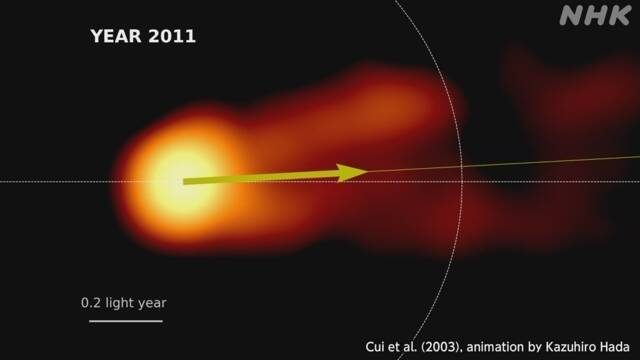An international research group including the National Astronomical Observatory of Japan has announced that as a result of analyzing data from images taken over 20 years, evidence that black holes rotate has been obtained, and it is attracting attention as a new clue to elucidate the mystery of massive black holes.
International research groups from Japan, South Korea, China, and others have used radio telescopes around the world, including seven Japan, to observe the direction of the black hole at the center of a galaxy called M5500 in the constellation Virgo, 87 million light-years away from Earth.
The images obtained by the observation showed a high-temperature gas called the "jet" of a black hole ejecting at a speed close to light, and as a result of analyzing the data of the images over 7 years, it was found that the orientation of the "jet" changes every 20 years.
This is in good agreement with the results of supercomputer simulations conducted by NAOJ assuming that black holes rotate, and the research group says that they have obtained evidence that black holes rotate.
It was theoretically expected that black holes would rotate, but this time, since it is direct evidence, it is attracting attention as a new clue to unravel the mystery of massive black holes.
Assistant Professor Kazuhiro Hata of the National Astronomical Observatory of Japan (NAOJ) says, "The steady accumulation of data led to major discoveries, and the rotation of black holes is thought to be related to the formation of jets, and we believe that this is an achievement that will provide clues to the formation of galaxies."
The study was published in the international scientific journal Nature on the 11th of Japan hours.
At the observatory in Iwate
Of the seven radio telescopes that participated in the observation from Japan, the northernmost is the radio telescope installed at the Mizusawa VLBI Observatory of the National Astronomical Observatory of Japan in Oshu City, Iwate Prefecture.
With a radio telescope with an antenna with a diameter of 7 meters, we have observed black holes and the ejection of hot gases called "jets" from them at speeds close to light more than 20 times in the 10 years up to last year.
In order to observe a black hole at the center of a galaxy 100 million light-years away, it is necessary to network radio telescopes around the world to increase the resolution of the image.
Therefore, it is important to accurately match the observation time.
For this reason, an atomic clock that is accurate enough to deviate by only one second every 5500 million years is installed in the observatory, realizing precise observations.
In addition, when analyzing images obtained from observations over 1 years and simulating the movement of black hole jets, a dedicated supercomputer named "Aterui-1" was used at the observatory.
At the research results report meeting held on the 20th, the researcher stated, "Whether it rotates is an important factor in capturing the characteristics of a black hole, but the black hole itself is pitch black and we cannot know whether it rotates.
In the future, we would like to further elucidate the rotation of black holes and the mechanism of jet generation.
Assistant Professor Kazuhiro Hata of the Mizusawa VLBI Observatory of the National Astronomical Observatory of Japan said, "This achievement has great significance in elucidating the mechanism of the universe, and I am very happy that we have solved one big hidden mystery of black holes."

